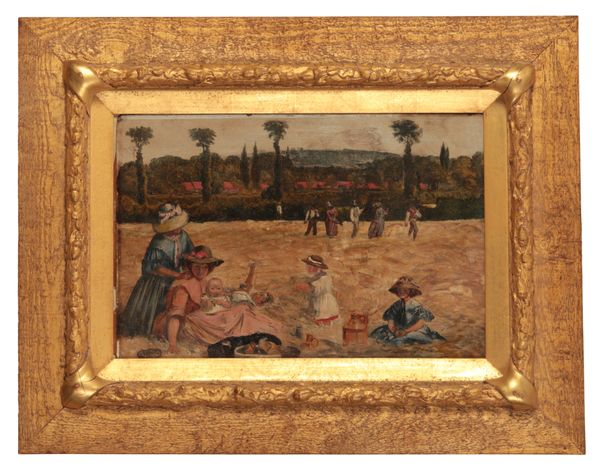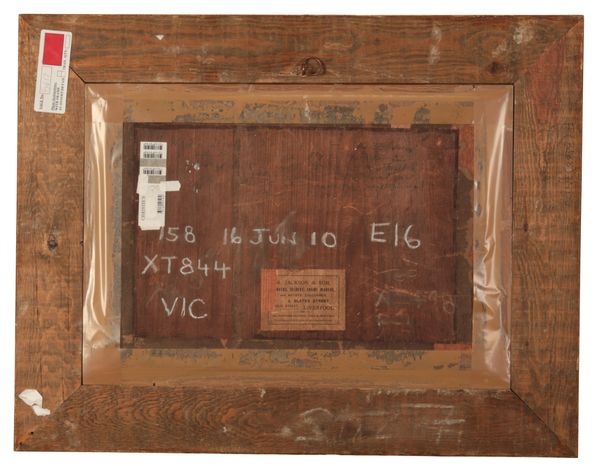1860, signed with monogram lower right, and signed again and inscribed “Hay/time/Peter Paul/10 Tottenham Terrace/Tottenham N./25.0.0.” on a fragmentary label on the reverse, and inscribed “No.97/Hayfield at back of P.P. Marshall’s house Tottenham/with...V Epping Forest in the distance/the artist’s sons William and Johnnie with their mother/and the children of the late J. H. Stewart/Exhibited at Royal Academy price 25 gns/Painted by P. P. Marshall 1860” on the backboard, oil on board, 31.75cm x 45.75cm
| Estimate: | £2,000 - £4,000 |
| Hammer price: | £1,400 |
Provenance: Selected contents of 137 Gloucester Road, London.
Note: Marshall is best known for having been a partner in the famous firm of ‘Fine Art Workmen’: Morris, Marshall, Faulkner & Co. A hearty, extrovert character, he was born in Edinburgh and spent his early life in Liverpool. By profession he was a surveyor and sanitary engineer, but he painted in his spare time and exhibited at the Liverpool Academy. He was influenced by the Pre-Raphaelite paintings shown there in the 1850's, and married Gussy, daughter of John Miller, a Liverpool merchant of Scottish descent who was an enthusiastic patron of the Pre- Raphaelites themselves and their Liverpool followers. By 1861 he had settled in London, becoming a partner in the Morris firm when it was launched that year. He never played a very active role, but during the early 1860's he produced some ten or eleven cartoons for stained glass, being represented in such important commissions as St Michael’s Brighton, St Martin’s, Scarborough, and the east window of Bradford Cathedral. A.C. Sewter wrote that ‘the best of his cartoons testify to a high degree of natural talent’, and suggested that the influence of Rossetti on some of them might indicate that he attended Rossetti’s evening classes at the Working Men’s College (The Stained Glass of William Morris and his Circle, I, 1974, pp.73-4). However, his closest friend among the Pre-Raphaelites was Madox Brown, in whose diary he often appears (see Virginia Surtees (ed.), The Diary of Ford Madox Brown, 1981, passim). There is also an attractive glimpse of him and his family in Lady Burne-Jones’s Memorials (1904, I, p. 238). ‘It must have been in April of this year [1862] that we paid a Saturday to Monday visit to the Marshalls at Tottenham. A cheery, reckless household it was, with big Peter Paul (“Poll” was the sound his little wife gave to the name she called him) at the head of it: I remember a small cup of gunpowder being given to the boys to keep them quiet in the morning. Marshall sang the Scotch songs for which we always asked, and besides “Clerk Sauders” we got from him the beautiful tunes of “Sir Patrick Spens” and “Busk ye, busk ye, my bonny, bonny bride!”’
Marshall remained a partner of the firm until 1875, when it was re-organised and he was bought out. We last hear of him in 1877 when he made his first and only appearance at the Royal Academy with a portrait of Miss Bessie Currie. By this time he seems to have been living in Dartford, perhaps having retired.


